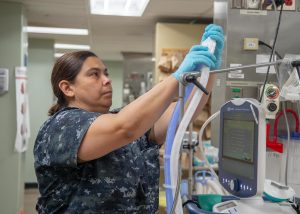Spontaneous Modes Versus Control Modes
As we have described in Chapter 3, in a spontaneous mode, the patient will initiate a breath from the ventilator and then the ventilator will “support” the patient. It can help eliminate some of the work that the patient is doing to breath by the application of additional pressure to overcome how much the patient is working. Work of breathing can be assessed subjectively by looking at how fast they are breathing and if they are using accessory muscles to breathe.

The key to this process is that the patient must have an intact neurological drive to breathe. They trigger their own breaths and have their diaphragm involved in pulling the breath into the lung and then exhaling. Patients also decide the frequency of each breath completely on their own. The ventilator will sense the patient-initiated efforts with a flow or pressure trigger (see Chapter 3) and deliver a set amount of air to augment the patient’s own breath. If the patient’s internal respiratory rate is not adequate to manage their CO2 and oxygen levels, they do not have a fully intact drive to breathe and may need a control mode or they will deteriorate.
Normal physiologic breaths are not all uniform. Most people take a variety of breaths every minute, including frequent sigh breaths, or have variability in their respiratory rate. Control modes do not allow for any of these variations, and the size of the breath or frequency only changes when the clinician changes the settings. This inflexibility can quickly lead to asynchrony discomfort for the patient. In spontaneous modes, however, the diaphragm is active in triggering, expanding the lungs and relaxing for exhalation once the breath is the desired volume. These variables are controlled by the neurotransmitters in the brain and can change from breath to breath if needed.
Spontaneous modes of ventilation allow for a return of some of the normal physiologic breathing processes. The chemoreceptors of the brain are active at triggering the initiation of breaths and the diaphragm is triggered to contract. This approach maintains some work in the respiratory muscles and decreases the risk of muscle wasting.
The risk of muscle wasting—or muscle atrophy—is key to the necessity of spontaneous modes. Spontaneous modes of ventilation are beneficial as it helps maintain involvement of respiratory muscles such as the diaphragm. Remember Chapter 1? We discussed the key involvement of the diaphragm in creating the negative pressure that pulls the breath into the lungs. The diaphragm is the most important muscle involved in a person spontaneously breathing. Like all muscles, if not used, the diaphragm starts to weaken.
Control modes of ventilation do not allow the diaphragm to be fully involved in breathing and can cause the diaphragm to atrophy and weaken. This muscle weakening and loss can contribute to patients having difficulty taking over their breathing and being strong enough to breathe on their own. The quicker a health care practitioner can allow a patient to start using their own respiratory muscles to breathe, the better. A fast turnaround will decrease the muscle atrophy that can occur. Spontaneous modes are the number one way that diaphragm use can be maintained and patients will have an easier time taking over their breathing needs without the support of a ventilator.
Though unable to fully eliminate the need for mechanical ventilation, the creation of spontaneous modes of ventilation was key in helping address these concerns.
Key Concept
Summary of Control vs. Spontaneous Modes
The following table summarizes the key differences between control modes and spontaneous modes:
| Control Modes | Spontaneous modes | |
|---|---|---|
| Drive to breathe | No drive to breathe needed | Needs to be breathing spontaneously |
| Oxygen | Can help give additional oxygen | Can help give additional oxygen |
| Elevated CO2 levels | Used to fix abnormal gases | Can only augment normal breathing; not indicated for very high CO2 levels |
| Sedation level | Usually requires more sedation | Much more comfortable, less sedation |
| Work of Breathing | Patient is sedated and ventilator completely overtakes the muscles—they are not actively working | Can give extra support to unload the work of breathing, but the muscles still work a little |
| Maintaining muscle strength | The diaphragm is not involved in the creation or delivery of the breath | The diaphragm must contract and be involved. Helping maintain muscle strength and decrease muscle wasting |
| Level of Invasiveness | More invasive, less physiologic | More physiologic; spontaneous modes are used during the transition off of ventilation (weaning) |
Media Attributions
- tube-adjustment © U.S. Pacific Fleet is licensed under a CC BY (Attribution) license

